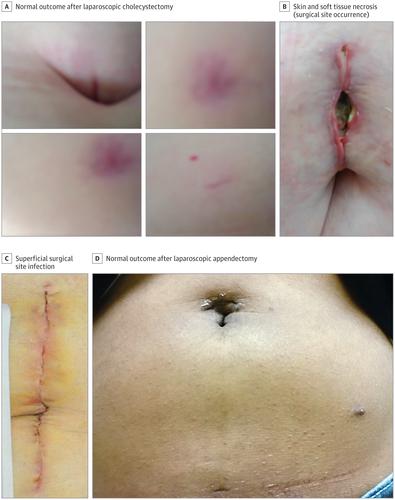JAMA Surgery ( IF 16.9 ) Pub Date : 2019-02-01 , DOI: 10.1001/jamasurg.2018.3861 Kristy Kummerow Broman 1, 2 , Cameron E. Gaskill 3 , Adil Faqih 1 , Michael Feng 1 , Sharon E. Phillips 1 , William B. Lober 4 , Richard A. Pierce 1 , Michael D. Holzman 1 , Heather L. Evans 3 , Benjamin K. Poulose 1

|
Importance Surgeons are increasingly interested in using mobile and online applications with wound photography to monitor patients after surgery. Early work using remote care to diagnose surgical site infections (SSIs) demonstrated improved diagnostic accuracy using wound photographs to augment patients’ electronic reports of symptoms, but it is unclear whether these findings are reproducible in real-world practice.
Objective To determine how wound photography affects surgeons’ abilities to diagnose SSIs in a pragmatic setting.
Design, Setting, and Participants This prospective study compared surgeons’ paired assessments of postabdominal surgery case vignettes with vs without wound photography for detection of SSIs. Data for case vignettes were collected prospectively from May 1, 2007, to January 31, 2009, at Erasmus University Medical Center, Rotterdam, the Netherlands, and from July 1, 2015, to February 29, 2016, at Vanderbilt University Medical Center, Nashville, Tennessee. The surgeons were members of the American Medical Association whose self-designated specialty is general, abdominal, colorectal, oncologic, or vascular surgery and who completed internet-based assessments from May 21 to June 10, 2016.
Intervention Surgeons reviewed online clinical vignettes with or without wound photography.
Main Outcomes and Measures Surgeons’ diagnostic accuracy, sensitivity, specificity, confidence, and proposed management with respect to SSIs.
Results A total of 523 surgeons (113 women and 410 men; mean [SD] age, 53 [10] years) completed a mean of 2.9 clinical vignettes. For the diagnosis of SSIs, the addition of wound photography did not change accuracy (863 of 1512 [57.1%] without and 878 of 1512 [58.1%] with photographs). Photographs decreased sensitivity (from 0.58 to 0.50) but increased specificity (from 0.56 to 0.63). In 415 of 1512 cases (27.4%), the addition of wound photography changed the surgeons’ assessment (215 of 1512 [14.2%] changed from incorrect to correct and 200 of 1512 [13.2%] changed from correct to incorrect). Surgeons reported greater confidence when vignettes included a wound photograph compared with vignettes without a wound photograph, regardless of whether they correctly identified an SSI (median, 8 [interquartile range, 6-9] vs median, 8 [interquartile range, 7-9]; P < .001) but they were more likely to undertriage patients when vignettes included a wound photograph, regardless of whether they correctly identified an SSI.
Conclusions and Relevance In a practical simulation, wound photography increased specificity and surgeon confidence, but worsened sensitivity for detection of SSIs. Remote evaluation of patient-generated wound photographs may not accurately reflect the clinical state of surgical incisions. Effective widespread implementation of remote postoperative assessment with photography may require additional development of tools, participant training, and mechanisms to verify image quality.
中文翻译:

伤口摄影对手术部位感染的远程术后评估的评估
重要性 外科医生对使用带有伤口照相的移动和在线应用程序来监视手术后的患者越来越感兴趣。早期使用远程护理来诊断手术部位感染(SSI)的工作表明,使用伤口照片增强患者对症状的电子报告可以提高诊断的准确性,但是目前尚不清楚这些发现是否可以在现实世界中重现。
目的 确定伤口照相如何影响外科医生在实际环境中诊断SSI的能力。
设计,设置和参与者 这项前瞻性研究比较了外科医生对腹部伤口手术后渐晕的成对评估(有或没有伤口摄影)以检测SSI。从2007年5月1日至2009年1月31日在荷兰鹿特丹的伊拉斯姆斯大学医学中心以及2015年7月1日至2016年2月29日在纳什维尔范德比尔特大学医学中心前瞻性收集病例小插图数据,田纳西州。外科医生是美国医学协会的会员,其自我指定的专科领域为普通,腹部,结肠直肠,肿瘤或血管外科,并于2016年5月21日至6月10日完成了基于互联网的评估。
介入 外科医生对有或没有伤口照相的在线临床检查进行了回顾。
主要结果和措施 外科医生对SSI的诊断准确性,敏感性,特异性,置信度和拟议管理。
结果 共有523名外科医生(113名女性和410名男性;平均[SD]年龄为53 [10]岁)完成了2.9次临床检查。对于SSI的诊断,增加伤口照相不会改变准确性(没有照片时为863的1512 [57.1%],有照片时为878的1512 [58.1%])。照片降低了灵敏度(从0.58到0.50),但特异性提高了(从0.56到0.63)。在1512例病例中的415例(占27.4%)中,增加了伤口照相改变了外科医生的评估(1512例中的215例[14.2%]由不正确改为正确,而1512例中的200例[13.2%]从正确变为不正确)。与没有伤口照片的小插图相比,外科医生在小插图包括伤口照片时的信心更大,无论他们是否正确识别了SSI(中位数,8 [四分位间距,6-9]与中位值,8 [四分位间距,7-9] ;P <.001),但是当小插曲包含伤口照片时,无论他们是否正确识别出SSI,他们更有可能使患者误诊。
结论和相关性 在实际模拟中,伤口摄影可提高特异性和外科医生的置信度,但会降低检测SSI的敏感性。对患者生成的伤口照片进行远程评估可能无法准确反映手术切口的临床状态。通过照相有效地广泛实施远程术后评估可能需要额外开发工具,参加者培训以及验证图像质量的机制。



























 京公网安备 11010802027423号
京公网安备 11010802027423号